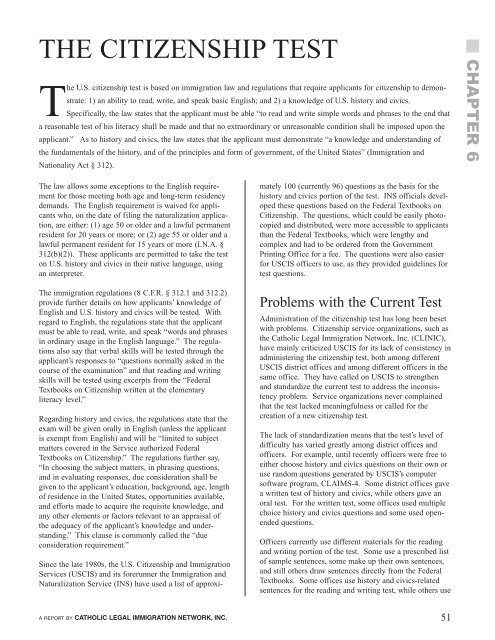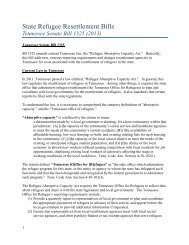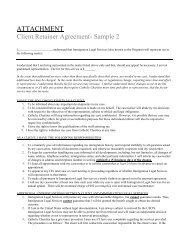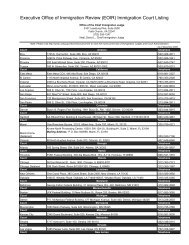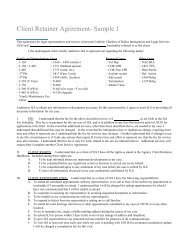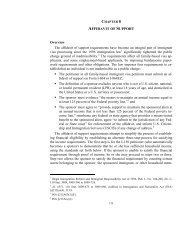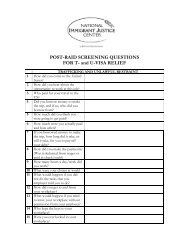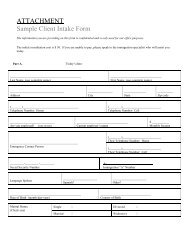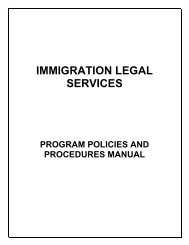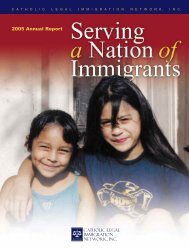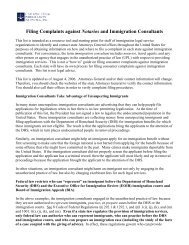THE CITIZENSHIP TEST - Catholic Legal Immigration Network, Inc.
THE CITIZENSHIP TEST - Catholic Legal Immigration Network, Inc.
THE CITIZENSHIP TEST - Catholic Legal Immigration Network, Inc.
Create successful ePaper yourself
Turn your PDF publications into a flip-book with our unique Google optimized e-Paper software.
<strong>THE</strong> <strong>CITIZENSHIP</strong> <strong>TEST</strong><br />
The U.S. citizenship test is based on immigration law and regulations that require applicants for citizenship to demonstrate:<br />
1) an ability to read, write, and speak basic English; and 2) a knowledge of U.S. history and civics.<br />
Specifically, the law states that the applicant must be able “to read and write simple words and phrases to the end that<br />
a reasonable test of his literacy shall be made and that no extraordinary or unreasonable condition shall be imposed upon the<br />
applicant.” As to history and civics, the law states that the applicant must demonstrate “a knowledge and understanding of<br />
the fundamentals of the history, and of the principles and form of government, of the United States” (<strong>Immigration</strong> and<br />
Nationality Act § 312).<br />
CHAPTER 6<br />
The law allows some exceptions to the English requirement<br />
for those meeting both age and long-term residency<br />
demands. The English requirement is waived for applicants<br />
who, on the date of filing the naturalization application,<br />
are either: (1) age 50 or older and a lawful permanent<br />
resident for 20 years or more; or (2) age 55 or older and a<br />
lawful permanent resident for 15 years or more (I.N.A. §<br />
312(b)(2)). These applicants are permitted to take the test<br />
on U.S. history and civics in their native language, using<br />
an interpreter.<br />
The immigration regulations (8 C.F.R. § 312.1 and 312.2)<br />
provide further details on how applicants’ knowledge of<br />
English and U.S. history and civics will be tested. With<br />
regard to English, the regulations state that the applicant<br />
must be able to read, write, and speak “words and phrases<br />
in ordinary usage in the English language.” The regulations<br />
also say that verbal skills will be tested through the<br />
applicant’s responses to “questions normally asked in the<br />
course of the examination” and that reading and writing<br />
skills will be tested using excerpts from the “Federal<br />
Textbooks on Citizenship written at the elementary<br />
literacy level.”<br />
Regarding history and civics, the regulations state that the<br />
exam will be given orally in English (unless the applicant<br />
is exempt from English) and will be “limited to subject<br />
matters covered in the Service authorized Federal<br />
Textbooks on Citizenship.” The regulations further say,<br />
“In choosing the subject matters, in phrasing questions,<br />
and in evaluating responses, due consideration shall be<br />
given to the applicant’s education, background, age, length<br />
of residence in the United States, opportunities available,<br />
and efforts made to acquire the requisite knowledge, and<br />
any other elements or factors relevant to an appraisal of<br />
the adequacy of the applicant’s knowledge and understanding.”<br />
This clause is commonly called the “due<br />
consideration requirement.”<br />
Since the late 1980s, the U.S. Citizenship and <strong>Immigration</strong><br />
Services (USCIS) and its forerunner the <strong>Immigration</strong> and<br />
Naturalization Service (INS) have used a list of approximately<br />
100 (currently 96) questions as the basis for the<br />
history and civics portion of the test. INS officials developed<br />
these questions based on the Federal Textbooks on<br />
Citizenship. The questions, which could be easily photocopied<br />
and distributed, were more accessible to applicants<br />
than the Federal Textbooks, which were lengthy and<br />
complex and had to be ordered from the Government<br />
Printing Office for a fee. The questions were also easier<br />
for USCIS officers to use, as they provided guidelines for<br />
test questions.<br />
Problems with the Current Test<br />
Administration of the citizenship test has long been beset<br />
with problems. Citizenship service organizations, such as<br />
the <strong>Catholic</strong> <strong>Legal</strong> <strong>Immigration</strong> <strong>Network</strong>, <strong>Inc</strong>. (CLINIC),<br />
have mainly criticized USCIS for its lack of consistency in<br />
administering the citizenship test, both among different<br />
USCIS district offices and among different officers in the<br />
same office. They have called on USCIS to strengthen<br />
and standardize the current test to address the inconsistency<br />
problem. Service organizations never complained<br />
that the test lacked meaningfulness or called for the<br />
creation of a new citizenship test.<br />
The lack of standardization means that the test’s level of<br />
difficulty has varied greatly among district offices and<br />
officers. For example, until recently officers were free to<br />
either choose history and civics questions on their own or<br />
use random questions generated by USCIS’s computer<br />
software program, CLAIMS-4. Some district offices gave<br />
a written test of history and civics, while others gave an<br />
oral test. For the written test, some offices used multiple<br />
choice history and civics questions and some used openended<br />
questions.<br />
Officers currently use different materials for the reading<br />
and writing portion of the test. Some use a prescribed list<br />
of sample sentences, some make up their own sentences,<br />
and still others draw sentences directly from the Federal<br />
Textbooks. Some offices use history and civics-related<br />
sentences for the reading and writing test, while others use<br />
A REPORT BY CATHOLIC LEGAL IMMIGRATION NETWORK, INC. 51
sentences about daily life. These discrepancies have<br />
resulted in a citizenship test that is unfair because there are<br />
widely varying degrees of difficulty and no standard way<br />
to test and evaluate applicants’ knowledge. Applicants do<br />
not know what to expect or how best to prepare for the test.<br />
Citizenship instructors try to balance the need to teach<br />
broad naturalization and citizenship information with the<br />
vagaries of USCIS district office styles.<br />
Moreover, some officers are not familiar with the due<br />
consideration requirement or do not apply it as required by<br />
the regulations. One USCIS naturalization supervisor at a<br />
local district office told citizenship service organizations<br />
that his officers used randomly generated history and<br />
civics questions from the computer, and could not deviate<br />
from these questions. This practice conflicted with<br />
existing USCIS policy guidance at that time that required<br />
officers to review the randomly generated questions and<br />
determine if any were too advanced for the applicant.<br />
Reasons for Test Revision<br />
The U.S. Commission on <strong>Immigration</strong> Reform, as<br />
mandated by the <strong>Immigration</strong> Act of 1990, produced a<br />
report about immigration and citizenship in 1997 entitled,<br />
Becoming an American: <strong>Immigration</strong> and Immigrant Policy.<br />
In its report, the commission criticized the citizenship test<br />
for not adequately assessing whether applicants have a<br />
“meaningful knowledge” of U.S. history and civics and an<br />
ability to communicate in English. The commission noted<br />
that the civics test “relies on memorization of discrete facts<br />
rather than on substantive understanding of the basic<br />
concepts of civic participation.” The commission also criticized<br />
the test’s “lack of uniform standards” and called on<br />
USCIS to develop a new citizenship test with the assistance<br />
of professional educators, pedagogical experts, and standardized<br />
test providers. In addition, the commission recommended<br />
separating the English portion of the test from the<br />
interview to reduce applicant anxiety and increase officers’<br />
efficiency. The commission also recommended that<br />
Congress reduce the years of residency required to qualify<br />
for the age and residency-based English exemption. 1<br />
Role of Citizenship Test<br />
Preparation Classes<br />
While citizenship service organizations generally agree<br />
with the commission’s criticism that the test lacks uniform<br />
standards, most do not agree that it lacks inherent meaning.<br />
The lack-of-meaning argument has been promoted chiefly<br />
by social conservatives, who believe the current test lacks<br />
key concepts and encourages memorization.<br />
Service organizations and those who work directly with<br />
immigrants preparing for the citizenship test have noted that<br />
the process of preparing for the test is very meaningful,<br />
particularly for those who attend test preparation classes.<br />
The scope of the classes usually goes far beyond memorizing<br />
the 96 questions to include substantive lessons about<br />
constitutional freedoms, key historical figures, and the<br />
rights and responsibilities of citizenship. It is noteworthy<br />
that the immigrants who attend test preparation classes and<br />
therefore experience a more “meaningful” citizenship test<br />
are typically those who are low-income, have low literacy,<br />
and speak limited English. In other words, they need to take<br />
a class in order to pass the test. For those higher income<br />
immigrants who are well-educated and able to prepare for<br />
the test without assistance by memorizing the 96 questions,<br />
the test may, indeed, not be as meaningful. Many citizenship<br />
service organizations suggest that the best solution for<br />
any lack of meaningfulness in the test is modification of the<br />
current list of 96 questions, more funding to expand the<br />
availability of citizenship classes, or mandatory attendance<br />
of citizenship classes in lieu of a test.<br />
USCIS Testing Guidance<br />
In an effort to respond to the criticisms of the commission,<br />
USCIS issued policy guidance in December 2000 that<br />
sought to standardize the citizenship test by describing in<br />
detail how the test would be administered and how pass<br />
rates would be determined (Policy Memorandum No. 73).<br />
The guidance states that the applicant’s ability to speak<br />
English will be deemed sufficient if the applicant “can<br />
respond meaningfully to questions relevant to the determination<br />
of eligibility.” The applicant is not required to<br />
“understand every term, word, or phrase on the N-400<br />
application” and the officer is required to repeat and<br />
rephrase questions for the applicant as necessary.<br />
For the English reading test, the guidance strongly encourages<br />
officers to use sentences drawn from an official list,<br />
called “Sample Sentences for Written English Testing.”<br />
The applicant should be given the opportunity to read up to<br />
three sentences if necessary, and will pass the reading test<br />
if he or she can read “one sentence in a manner suggesting<br />
to the officer that the applicant appears to understand the<br />
meaning of the sentence at a general level.”<br />
For the English writing test, the guidance encourages<br />
officers to use sentences from the same list as the reading<br />
test. Each applicant should be given up to three opportunities<br />
to write a sentence if necessary, and the officer should<br />
repeat each sentence clearly if asked. The applicant will<br />
pass the writing test if he or she can write “one sentence<br />
that would be understandable as written to a reasonable<br />
person.” The guidance states that the applicant should not<br />
be failed because of spelling, capitalization, or punctuation<br />
errors “unless the errors would prevent a reasonable person<br />
from understanding what the sentence means.”<br />
52<br />
A More Perfect Union: A National Citizenship Plan ■ The Citizenship Test
For the U.S. history and civics test, the guidance states that<br />
applicants should be given ten questions and encourages<br />
officers to draw questions from the official list of 96 questions.<br />
The applicant must answer at least six of the ten<br />
questions correctly for a passing score.<br />
Citizenship service organizations that had criticized the<br />
test’s lack of standardization were generally pleased with<br />
the December 2000 policy guidance and encouraged<br />
USCIS to strengthen the guidance by making it binding.<br />
However, USCIS has not turned the guidance into regulation,<br />
and instead has treated it as a temporary fix until the<br />
citizenship test can be overhauled and revised, as recommended<br />
by the U.S. Commission on <strong>Immigration</strong> Reform.<br />
USCIS Efforts to Revise the<br />
Citizenship Test<br />
USCIS began to work intensively on the redesign of the<br />
citizenship test in 2002, and contracted with MetriTech, a<br />
company experienced in designing standardized tests for<br />
schools and motor vehicle departments, to design a new<br />
test and study guide. USCIS invited citizenship service<br />
organizations to participate in the redesign process in June<br />
2002, when MetriTech conducted a stakeholder survey on<br />
what content should be included in the test and what level<br />
of difficulty or understanding should be required of applicants.<br />
Many service organizations complained that the<br />
number of respondents was limited because the survey was<br />
not widely distributed and did not give enough turnaround<br />
time for them to participate. Survey results were presented<br />
at a July 2002 meeting with service organizations. The<br />
main topics identified for inclusion in the test included the<br />
Constitution, the Bill of Rights, the Declaration of<br />
Independence, democratic principles and values, key<br />
colonial figures and their contributions, the separation of<br />
powers, and the amendment process.<br />
In July 2002 USCIS invited citizenship service organizations<br />
to attend a bias review of sample test questions and a<br />
draft study guide. The proposed test in the bias review was<br />
significantly longer and more difficult than the current test,<br />
with 20 multiple choice questions on history and civics, 16<br />
multiple choice questions on reading comprehension, four<br />
writing tasks, and two speaking tasks. Service organizations<br />
were alarmed by the level of difficulty of the test<br />
questions, and raised serious concerns with USCIS staff<br />
working on the redesign. However, the staff did not<br />
indicate a willingness to consider these concerns or change<br />
course. As a result, many organizations sent letters to the<br />
USCIS director of operations in August 2002 expressing<br />
their concerns about the test redesign process.<br />
Formation of the Stakeholder<br />
Working Group<br />
The director of operations responded by reassigning<br />
responsibility for the test redesign process to a different<br />
staff person who had extensive experience working with<br />
service organizations. The new project leader formed a<br />
stakeholder working group with citizenship service organizations<br />
and began meeting with them regularly. The initial<br />
working group was small and consisted of about ten organizations,<br />
including CLINIC, the National Association of<br />
Latino Elected and Appointed Officials, the New York<br />
<strong>Immigration</strong> Coalition, the Illinois Coalition for Immigrant<br />
and Refugee Rights, and the Hebrew Immigrant Aid<br />
Society. Most of the organizations represented national or<br />
state networks of citizenship service providers. The group<br />
also included ethnic-based service organizations and state<br />
immigration coalitions. The USCIS test redesign project<br />
leader sought the input of other professionals as well. In<br />
order to determine the body of knowledge to be used for<br />
the history and civics test, the project leader created a<br />
panel of U.S. history and civics experts from academia and<br />
think tanks, representing the political spectrum. The panel<br />
was also tasked with drafting a study guide for the history<br />
and civics test.<br />
The First Pilot of the Test<br />
At the same time, USCIS proceeded with plans to pilot the<br />
proposed English test material in six USCIS offices. The<br />
first phase of the pilot included only the English reading,<br />
writing, and speaking portions of the test, and not the<br />
history and civics section. Participation was voluntary, and<br />
the pilot questions were asked after the interview and had<br />
no bearing on applicants’ citizenship eligibility. Data<br />
collected from the first pilot was to be used to redesign the<br />
English materials and to set up scales for grading the<br />
English test. The first pilot was conducted from March to<br />
June 2003 in Sacramento, Atlanta, Newark, and two sites<br />
in Los Angeles—Bellflower and El Monte.<br />
In August 2003 the working group received a draft copy of<br />
the pilot results. Among the findings of concern to service<br />
organizations was that 10 percent of those who passed the<br />
current test performed poorly on the pilot test. Reading<br />
and speaking were the most difficult portions of the pilot.<br />
In addition, data indicated that poor performers on the pilot<br />
were more likely to report Spanish or Vietnamese as their<br />
native language. Following discussions of the results with<br />
the working group, USCIS agreed to obtain additional<br />
input on the proposed redesigns from educators working<br />
with low-literate students by expanding the working group<br />
and to test alternative formats in the second phase of the<br />
pilot, planned for late 2003.<br />
A REPORT BY CATHOLIC LEGAL IMMIGRATION NETWORK, INC. 53
In late 2003 the panel of U.S. history and civics experts<br />
produced a draft study guide that service organizations<br />
widely criticized for being “poorly written, poorly organized,<br />
and filled with cultural and political bias.” 2 In<br />
addition, service organizations agreed that the guide was<br />
written at too high a reading level and lacked content on<br />
civic participation. Calling the study guide “fatally<br />
flawed,” they wanted USCIS to discard it and start over.<br />
USCIS refused to discard the draft study guide, but<br />
agreed with the service organizations’ request to contract<br />
with an expert on English as a second language (ESL) to<br />
rewrite it at a lower reading level that would be accessible<br />
for applicants who speak basic English, and also to have a<br />
panel of ESL experts review the redesigns and provide<br />
additional feedback.<br />
On January 14 and 15, 2004, USCIS organized a national<br />
stakeholder conference to gather input on the test content,<br />
format, and study guide. Approximately 125 people<br />
attended, including USCIS officers, ESL and citizenship<br />
teachers, and representatives from community-based and<br />
service organizations assisting immigrants in the naturalization<br />
process. It was a unique gathering of people and<br />
organizations that had not met before. The agenda<br />
included breakout sessions on: item formats for testing<br />
English reading, writing, and speaking skills; item formats<br />
for U.S. history and civics; the structure of the study guide;<br />
and U.S. history and civics content; and it provided opportunities<br />
for group feedback and discussion. Service organizations<br />
were generally pleased with the quality and<br />
productivity of the discussion, and the representative mix<br />
of attendees. However, USCIS did not feel that there was<br />
adequate consensus in participant feedback, so the staff<br />
compiled a list of recommendations collected at the conference<br />
and asked attendees to complete a survey, responding<br />
to the recommendations.<br />
Role of the National<br />
Academy of Sciences<br />
By spring 2004 USCIS and working group members had<br />
reached a general agreement that the methodology of test<br />
design and assessment was of great importance and was<br />
not within the expertise of the group or the USCIS staff<br />
working on the redesign. As a result, and at the request of<br />
the working group, USCIS contracted with the National<br />
Academy of Sciences (NAS) to study and guide the test<br />
redesign process. Specifically, NAS was asked to assess<br />
the validity, reliability, and fairness of a redesigned test and<br />
provide guidance on the redesign process.<br />
NAS formed a steering committee of 18 experts in ESL,<br />
adult education, U.S. history and civics, and psychometrics.<br />
The committee was co-chaired by Lorraine<br />
McDonnell, Department of Political Science, University of<br />
California, Santa Barbara, and Barbara Plake, Buros<br />
Center for Testing, University of Nebraska, Lincoln. NAS<br />
collected stakeholder input in a series of meetings and<br />
organized a conference in Washington, D.C., on December<br />
15, 2004, that drew about 50 stakeholders from across the<br />
country. A few days before the conference, NAS produced<br />
an interim report with recommendations on the test development<br />
process.<br />
The NAS report had four key recommendations:<br />
1) USCIS should put in place an advisory structure to<br />
advise the agency in making important decisions<br />
about the naturalization test redesign.<br />
2) Aided by a technical advisory panel, USCIS should<br />
create a detailed plan for test development, to be<br />
reviewed by an oversight committee. The research<br />
and test development plan should comply with testing<br />
standards and include all of the necessary steps for<br />
developing a valid, reliable, and fair test.<br />
3) Work on developing the content frameworks,<br />
including publishing the history and civics framework<br />
in the Federal Register, should cease until a clear,<br />
transparent, and publicly accountable process is<br />
defined and vetted with an oversight group.<br />
4) After a determination has been made about the<br />
various item formats that will be used on the<br />
redesigned test, USCIS and its testing contractor<br />
should develop a detailed plan for a standard setting,<br />
with input from the technical advisory group and a<br />
final recommendation by the oversight committee.<br />
The Office of<br />
Citizenship in Charge<br />
In late March 2005 USCIS made a surprise announcement<br />
to service organizations regarding three major changes in<br />
the citizenship test redesign process. First, responsibility<br />
for the test redesign would be shifted from USCIS operational<br />
staff to the Office of Citizenship (OoC). Second,<br />
USCIS’s contract with the NAS would be terminated and<br />
OoC would not implement NAS’s recommendation to<br />
create a broad advisory panel. Third, the target date for<br />
completing the test redesign would be January 2007.<br />
Citizenship service organizations strongly opposed these<br />
changes, and voiced a number of objections to USCIS in<br />
meetings and in writing. A major concern was the January<br />
2007 target date, which they felt was arbitrary and did not<br />
recognize the complexities of the test redesign process.<br />
Previously, USCIS staff had made a commitment to service<br />
organizations that they would have one year between test<br />
redesign completion and implementation to prepare immi-<br />
54<br />
A More Perfect Union: A National Citizenship Plan ■ The Citizenship Test
grant communities for the new test. Service organizations<br />
noted that the redesign will have a major impact on<br />
millions of immigrants for decades to come and should not<br />
be rushed.<br />
Another concern of service organizations was staffing<br />
changes. Since the three USCIS staff who were overseeing<br />
the test redesign process declined to be reassigned, service<br />
organizations worried that years of accumulated knowledge,<br />
information, and stakeholder input might be lost in<br />
the transition to the OoC. In addition, the large workload<br />
created by the test redesign process might detract from<br />
OoC’s mission and current initiatives promoting citizenship<br />
instruction and training. Moreover, service organizations,<br />
which had requested the involvement of NAS, were pleased<br />
with its work and recommendations. They felt that the<br />
broad oversight committee recommended by NAS would<br />
bring the perspectives of a diverse group of constituents<br />
and stakeholders into the test redesign process and provide<br />
credibility for USCIS efforts.<br />
At an April 6, 2005, meeting with stakeholders, the OoC<br />
director offered assurances to the citizenship service organizations.<br />
The director argued that the test redesign process<br />
was well within the mission of the OoC, and pledged to<br />
continue meeting with the stakeholder working group and<br />
keep the redesign process transparent. He also stated that<br />
he was committed to creating a fair and meaningful test<br />
that would not be more difficult that the current one. In<br />
addition, he assured service organizations that the January<br />
2007 deadline was a “flexible target date” and not set in<br />
stone. At the same meeting, service organizations<br />
presented the OoC director with a list of guiding principles<br />
for the test redesign, signed by ten organizations, and a list<br />
of questions about the test and the redesign process.<br />
The Records Study<br />
In summer 2005 OoC conducted the records study long<br />
planned by USCIS. The purpose was to determine the<br />
actual pass/fail rate of applicants as a baseline for the<br />
redesigned test. This information was necessary because<br />
service organizations had insisted, and both USCIS and<br />
OoC had promised, that the redesigned test would not raise<br />
the failure rate and present a higher bar to applicants. The<br />
study was based on a random sample of approximately<br />
3,000 naturalization case files completed in FY 2003 and<br />
FY 2004. Most of the files were located in USCIS’s<br />
central storage facility, but some had to be requested from<br />
local USCIS offices, slowing the process. Service organizations<br />
were consulted and provided input on what kinds of<br />
data to collect from the files.<br />
At the same time, USCIS’s contract with MetriTech ended,<br />
and OoC awarded the competitive contract to a new<br />
company. Service organizations had increasingly criticized<br />
MetriTech for its lack of expertise in adult and ESL education.<br />
In October 2005 OoC introduced service organizations<br />
to its new contractor, the American Institutes for<br />
Research (AIR).<br />
The full results of the records study were presented to<br />
service organizations in a February 2006 report. The study<br />
showed that 84 percent of applicants passed the current<br />
citizenship test on the first try, and 95 percent passed it on<br />
the second try or a subsequent application. The study<br />
looked at various applicant characteristics and found lower<br />
pass rates for elders, refugees, applicants from the<br />
Caribbean and Central America (including Mexico), and<br />
applicants with more years of Lawful Permanent Resident<br />
status. There was no difference in pass rates by race,<br />
looking at Black, White, and Asian; however, the study did<br />
not break out Hispanics/Latinos.<br />
The Office of<br />
Inspector General Report<br />
In June 2005 the Department of Homeland Security’s<br />
Office of Inspector General (OIG) produced a report on<br />
the citizenship test redesign, noting several technical and<br />
policy challenges. OIG cited the conflict between the basic<br />
level of English required to pass the test and the requirement<br />
to demonstrate knowledge of abstract U.S. history<br />
and civics concepts that may exceed English ability. OIG<br />
also pointed out the challenge of providing due consideration<br />
within a more standardized test, and stated the need<br />
for “detailed and carefully construed standards” for<br />
applying due consideration in a redesigned test. In<br />
addition, OIG noted the challenge of creating a more<br />
meaningful test without raising the level of difficulty, and<br />
felt that the stated goal of not raising the fail rate called<br />
into question the need for a redesigned test. Based on<br />
these issues, OIG recommended that USCIS take steps<br />
immediately to standardize the current test while the new<br />
test is being developed.<br />
The Naturalization Test<br />
Redesign Project Plan Overview<br />
In July 2005 OoC met with service organizations and<br />
presented its Naturalization Test Redesign Project Plan<br />
Overview for feedback. The plan consists of six phases:<br />
discovery, test development, pre-implementation, implementation,<br />
and post-implementation. The discovery phase<br />
includes a records study, a due consideration study, an<br />
impact analysis, and a feasibility review. The feasibility<br />
A REPORT BY CATHOLIC LEGAL IMMIGRATION NETWORK, INC. 55
eview will describe testing alternatives and the benefits<br />
and cost of each and will identify and justify the recommended<br />
approach. The plan keeps the 2007 deadline for<br />
completion of test development, but provides one to two<br />
years for training, dissemination, and community outreach<br />
before implementation of the new test. Several organizations<br />
submitted written comments on the plan. As part of<br />
its plan, OoC also created an internal stakeholder group of<br />
OoC staff from the offices of field operations, general<br />
counsel, and policy and strategy.<br />
In redesigning the test, one alternative that OoC will<br />
consider is up-front testing, allowing applicants to pay a<br />
fee to take the test prior to submitting the citizenship<br />
application. Proponents believe this model has several<br />
advantages. It would save applicants time and money<br />
because those who could not pass the test would avoid<br />
applying. It would also give applicants who can pass the<br />
test a sense of self-confidence and would reduce their<br />
testing stress because the entire application would not be<br />
at stake. Applicants could take the test as often and as<br />
many times as they wanted. Up-front testing would<br />
increase USCIS’s efficiency because officers would not<br />
have to test applicants at the interview and workers would<br />
not have to process applications for those who are unable<br />
to pass the test. Service organizations recognize these<br />
advantages but have concerns about how to preserve<br />
reasonable accommodations for disabled applicants and<br />
due consideration. The fear is that officers would have no<br />
way of knowing applicants’ unique and individual circumstances<br />
in a walk-in situation.<br />
The Feasibility Review<br />
USCIS conducted the feasibility review in late 2005, gathering<br />
information through focus groups with communitybased<br />
organizations in the Washington, D.C. area. The<br />
purpose was to look at various options for changing the<br />
test and the testing process and conduct a cost vs. impact<br />
analysis of each option to determine the best course of<br />
action. The results were presented in a report to service<br />
organizations in early 2006. At the request of service<br />
organizations, OoC produced a separate report summarizing<br />
input received from groups outside the D.C. area.<br />
The feasibility review identified changes that could be<br />
made to improve test standardization and meaningfulness<br />
with the least amount of burden to USCIS. It was determined<br />
that changes to test procedures, format, and content<br />
would be the most burdensome and that training for USCIS<br />
officers, standardization, better test preparation, and<br />
increased outreach efforts would be the least.<br />
The TESOL Panel<br />
In early 2006 OoC formed a working group of ESL experts<br />
to advise on an appropriate English level for passing the<br />
test and to assist in writing test questions. The group met<br />
in early May 2006 for three days to examine the English<br />
reading and writing portions of the citizenship test, and it<br />
recommended that the high-beginning ESL level based on<br />
Department of Education reporting standards was most<br />
appropriate and consistent with <strong>Immigration</strong> and<br />
Nationality Act requirements. The group also decided to<br />
emphasize civics in the questions testing English reading<br />
and writing, wrote sample reading sentences, and created<br />
guidelines for testing applicants’ writing skills. The group<br />
used the current 96 questions along with additional content<br />
provided by OoC to write approximately 140 U.S. history<br />
and civics test questions at the high-beginning level. These<br />
questions were reviewed by civics experts. The group also<br />
developed English reading and writing items at the highbeginning<br />
level. The ESL group joined OoC’s contractor,<br />
AIR, to develop re-phrased questions from the N-400<br />
application at the high-beginning level for use by adjudicators<br />
in testing applicants’ ability to speak English in the<br />
citizenship interview.<br />
Interim Measures<br />
Based on OIG’s recommendation in its report on the test<br />
redesign, OoC is taking immediate steps to standardize the<br />
current test while the new test is being developed. For the<br />
history and civics test, OoC is weighing the current 96<br />
questions and creating preprinted forms of ten questions<br />
each that are equivalent in level of difficulty. This will<br />
replace the current system of using ten questions randomly<br />
generated by computer. OoC plans to have a due consideration<br />
version of the preprinted forms with less difficult<br />
questions. OoC is not changing the reading and writing<br />
portions of the English test, but it plans to limit the questions<br />
asked about the N-400 Form to those requiring basic<br />
spoken English, and to provide standardized, rephrased<br />
questions for USCIS officers to use when applicants do not<br />
understand a question. OoC implemented these interim<br />
measures in October 2006.<br />
Pilot Test Plan<br />
In November 2006, OoC presented a pilot test plan<br />
prepared by its contractor, AIR. The plan describes the<br />
selection of pilot sites, recruitment of participants, development<br />
of test materials, administration of the test,<br />
analysis of pilot test data, and preparation of a final report.<br />
Ten local USCIS offices were randomly selected to participate<br />
in the pilot. This group is comprised of large,<br />
medium, and small offices located throughout the U.S. To<br />
56<br />
A More Perfect Union: A National Citizenship Plan ■ The Citizenship Test
ecruit participants, USCIS will send a package to all<br />
applicants who apply for naturalization in each of the pilot<br />
sites. The package will include an explanation of the pilot<br />
test and study materials for the pilot test. Participation in<br />
the pilot will be voluntary. Applicants who pass the pilot<br />
test will be deemed to have met the English and civics<br />
testing requirement. Applicants who fail the pilot test will<br />
be given an opportunity to take the current citizenship test.<br />
Approximately 5,000 applicants will receive the pilot test.<br />
OoC expects that the pilot will begin in January 2007 and<br />
will last three to four months. AIR staff will visit each of<br />
the pilot sites to help train adjudicators and monitor the<br />
administration of the pilot test. AIR will also conduct<br />
focus groups with adjudicators at each of the pilot sites to<br />
collect their feedback on test materials, administration<br />
procedures, and scoring rubrics. AIR will analyze the data<br />
collected in the pilot and produce a report recommending<br />
the test items to be included in the final test, organizing the<br />
selected test items into test booklets of equally weighted<br />
difficulty, and suggesting possible revisions to test administration<br />
and scoring procedures for the final version of the<br />
new citizenship test.<br />
Citizenship service organizations have raised several<br />
concerns about the pilot. They favor the test being given to<br />
a diverse group of immigrants, and have noted that the<br />
ethnic diversity of pilot participants is extremely important<br />
to ensure that the new citizenship test does not have a<br />
disparate impact on any particular ethnic groups or nationalities.<br />
In addition, they are concerned that because participation<br />
is voluntary and not mandatory, applicants who<br />
struggle to pass the current citizenship test will likely opt<br />
out of the pilot, and the results will be skewed with a<br />
higher passing rate. OoC is relying on local communitybased<br />
organizations that work with these applicants to<br />
encourage them to participate in the pilot.<br />
The New Test Questions<br />
In November 2006, OoC released information about the<br />
redesigned citizenship test, including a list of 144 new<br />
study questions on U.S. history and civics that would be<br />
used in the pilot. Based on the pilot results, OoC plans to<br />
eliminate a number of the questions, reducing the final list<br />
to approximately 100 questions. As with the current test,<br />
applicants will still receive 10 questions and be required to<br />
answer six correctly to pass the history and civics test.<br />
The redesigned English test also will be similar to the<br />
current test. Applicants will have up to three chances to<br />
read and write a sentence in English. However, instead of<br />
studying a list of English sentences, applicants will study a<br />
vocabulary list of words that are used in the sentences. In<br />
addition, the new reading and writing sentences will cover<br />
U.S. history and civics. Applicants will be asked to read a<br />
sentence, and then they will be required to write the answer<br />
that is dictated to them. OoC plans to pilot 35 reading and<br />
35 writing test items. The English speaking test will<br />
continue to be based on the applicants’ answers to questions<br />
normally asked about the citizenship application<br />
during the course of the citizenship interview. However,<br />
USCIS examiners will be given a list of re-phrased questions<br />
they can choose to use if applicants do not understand<br />
a particular question.<br />
Conclusion<br />
As this report is being written, the redesign of the citizenship<br />
test is still in process and the outcome unknown. The<br />
new test has major implications for who will become<br />
citizens and will affect millions of applicants in the years<br />
to come. Of the eight million immigrants currently<br />
eligible for citizenship, 55 percent are estimated to have<br />
limited English proficiency, and one-quarter have less than<br />
a ninth grade education. The new test will determine<br />
whether U.S. citizenship remains accessible to all immigrants<br />
or only the privileged and well-educated.<br />
RECOMMENDATIONS:<br />
1 The new citizenship test should adhere to the current<br />
statutory requirements for level of difficulty and use of<br />
discretion. In particular, it should not exceed the<br />
current statutory requirement of evaluating the applicant’s<br />
ability to read and write “simple words and<br />
phrases” and to demonstrate an understanding of the<br />
“fundamentals” of history and civics. The revised test<br />
should also adhere to the current statutory requirement<br />
of not imposing “extraordinary or unreasonable conditions”<br />
on an applicant. A test that is considerably<br />
longer than the current test or more complex in structure<br />
and implementation would impose an unreasonable<br />
condition.<br />
2 In the new citizenship test, USCIS must preserve due<br />
consideration as provided in current law, and allow<br />
officers to use some discretion in testing based on the<br />
applicant’s background.<br />
3 The new citizenship test should not adversely impact<br />
vulnerable applicants, particularly the elderly, disabled,<br />
low-income, low-literate, and those who speak limited<br />
English. In addition, a new test should not adversely<br />
impact any specific ethnic, national, or language group.<br />
4 A new citizenship test must be flexible enough to<br />
accommodate applicants with special needs, such as<br />
those with disabilities.<br />
5 USCIS should ensure that the new citizenship test does<br />
not raise the failure rate and exclude more people from<br />
citizenship, but rather provides an opportunity for<br />
A REPORT BY CATHOLIC LEGAL IMMIGRATION NETWORK, INC. 57
greater success. The goal of the test redesign process<br />
should be to encourage more people to naturalize.<br />
6 At all stages, the citizenship test redesign process must<br />
be transparent and open to input by stakeholders,<br />
particularly from organizations that provide citizenship<br />
services. While keeping the process open to public<br />
scrutiny, USCIS must guard it from political interference.<br />
7 The study guide for the new test should be nonpartisan<br />
and accessible to applicants at the basic level of<br />
English. The guide should emphasize the economic,<br />
social, and civic contributions of immigrants to the<br />
United States, and should describe the rights and<br />
responsibilities of U.S. citizenship, with specific information<br />
on opportunities for civic participation. The<br />
guide should be available in alternate formats for applicants<br />
with disabilities.<br />
8 USCIS’s test redesign contractor must have expertise<br />
in adult education, adult literacy, and ESL education<br />
for adults.<br />
9 The costs of implementing and administering a<br />
redesigned citizenship test should not be borne by<br />
applicants through higher application fees that would<br />
further exclude low-income immigrants from the naturalization<br />
process.<br />
10 USCIS must train and monitor officers to ensure the<br />
redesigned citizenship test is implemented correctly.<br />
11 USCIS should ensure that the new citizenship test does<br />
not create any undue delay in the naturalization<br />
process.<br />
12 USCIS should provide funding to service organizations<br />
to support English and citizenship test preparation<br />
classes as part of the implementation of the new test.<br />
1 U.S. Commission on <strong>Immigration</strong> Reform. Report to<br />
Congress. Becoming an American: <strong>Immigration</strong> and<br />
Immigrant Policy (September 1997), p. 46-48.<br />
2 <strong>Catholic</strong> <strong>Legal</strong> <strong>Immigration</strong> <strong>Network</strong>, <strong>Inc</strong>. Letter to U.S.<br />
Citizenship and <strong>Immigration</strong> Services (January 21, 2004).<br />
58<br />
A More Perfect Union: A National Citizenship Plan ■ The Citizenship Test


